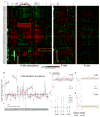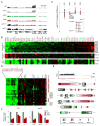Transcriptome-wide Analysis of Roles for tRNA Modifications in Translational Regulation
- PMID: 29198561
- PMCID: PMC5728682
- DOI: 10.1016/j.molcel.2017.11.002
Transcriptome-wide Analysis of Roles for tRNA Modifications in Translational Regulation
Abstract
Covalent nucleotide modifications in noncoding RNAs affect a plethora of biological processes, and new functions continue to be discovered even for well-known modifying enzymes. To systematically compare the functions of a large set of noncoding RNA modifications in gene regulation, we carried out ribosome profiling in budding yeast to characterize 57 nonessential genes involved in tRNA modification. Deletion mutants exhibited a range of translational phenotypes, with enzymes known to modify anticodons, or non-tRNA substrates such as rRNA, exhibiting the most dramatic translational perturbations. Our data build on prior reports documenting translational upregulation of the nutrient-responsive transcription factor Gcn4 in response to numerous tRNA perturbations, and identify many additional translationally regulated mRNAs throughout the yeast genome. Our data also uncover unexpected roles for tRNA-modifying enzymes in regulation of TY retroelements, and in rRNA 2'-O-methylation. This dataset should provide a rich resource for discovery of additional links between tRNA modifications and gene regulation.
Keywords: RNA modifications; noncoding RNA; protein translation; ribosome profiling; tRNA.
Copyright © 2017 Elsevier Inc. All rights reserved.
Figures






References
-
- Alexandrov A, Chernyakov I, Gu W, Hiley SL, Hughes TR, Grayhack EJ, Phizicky EM. Rapid tRNA decay can result from lack of nonessential modifications. Molecular cell. 2006;21:87–96. - PubMed
-
- Astrom SU, Bystrom AS. Rit1, a tRNA backbone-modifying enzyme that mediates initiator and elongator tRNA discrimination. Cell. 1994;79:535–546. - PubMed
-
- Birkedal U, Christensen-Dalsgaard M, Krogh N, Sabarinathan R, Gorodkin J, Nielsen H. Profiling of ribose methylations in RNA by high-throughput sequencing. Angew Chem Int Ed Engl. 2015;54:451–455. - PubMed
MeSH terms
Substances
Grants and funding
LinkOut - more resources
Full Text Sources
Other Literature Sources
Molecular Biology Databases

